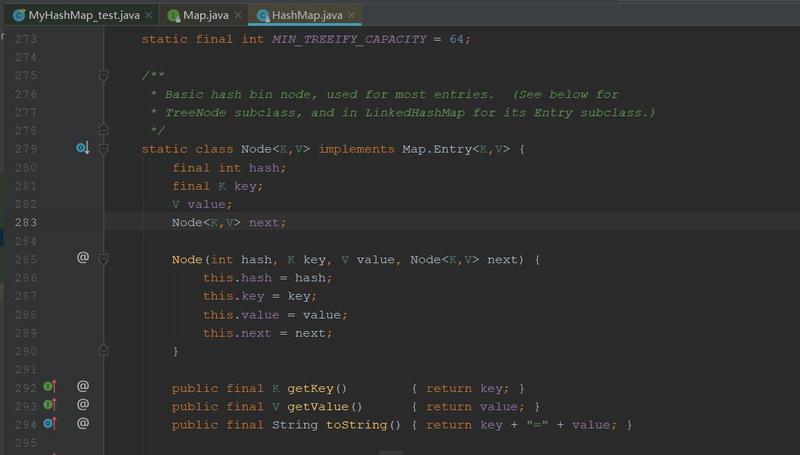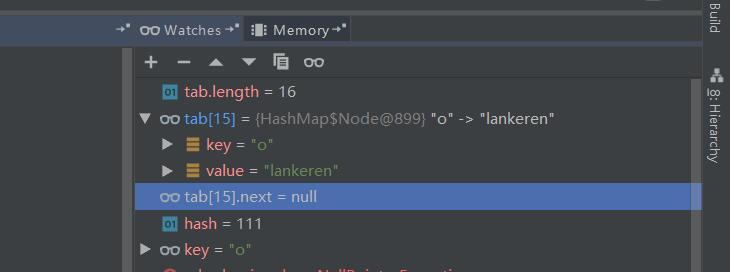【源码分析】HashMap(一)
花了几个小时的时间,给自己总结一下所学的
一、HashMap
HashMap 是基于哈希表 Map 接口的一个实现,通过 Key-Value ( key、value都支持 null )存放数据, 在 JDK1.7 时,底层是 数组 + 链表 , JDK1.8 改为了 数组 + 链表 + 红黑树
HashMap 实现了 Map 接口, HashMap 中的 Node 静态内部类则是实现了 Map 接口中的内部接口 Entry

静态内部类 Node 是一个单向链表, 对应HashMap的拉链式存储. 它实现了 getKey、getValue、setValue、hashCode、equals 这些函数
二、数组 + 链表 + 红黑树
HashMap 为什么采用这种实现方式
1. 容量、加载因子
容量 和
加载因子
HashMap 的默认初始容量为 16 ,加载因子为 0.75f
实际容量 = 16 * 0.75 = 12
加载因子指的是元素对容器的充满程度,当元素达到这个充满程度就会进行自动扩容
为什么默认规定负载因子是 0.75,而不是0.8,0.76
因为负载因子越大,表示可填充的程度越大,那么空间利用率越大,但链表的的长度就会越来越大,查询的效率就会降低,同时 hash冲突 的机会也会增加
负载因子越小,表示可填充的程度越小,那么空间的利用绿越小,造成空间资源浪费,但是链表的长度短,hash冲突的机会小,查询效率高
所以 0.75f 是官方给出的一种时间和空间权衡的 折衷选择
transient Node<K,V>[] table; // 存放内容的实体数组 transient int size; // 存放的大小 transient int modCount; // 被修改的次数 int threshold; // 临界值 = 容量 * 加载因子 final float loadFactor; // 加载因子
transient 关键字 表示不参与序列化过程
2. hash冲突
hashmap存放键值对时,通过对象的hashCode 算出 hash 值来确定存储位置的,当hashCode一样时,hash值就是一样的, 当存储的对象多时,可能会出现不同的对象 hash 值相同,这就是hash 冲突, hashmap 底层是通过链表来解决hash冲突的 .
3. 为什么转换成红黑树结构
hashmap默认初始化是链表存储的,当链表的长度过长时,查询效率慢,在相同条件下 链表的查询复杂度为O(n),树型的查询复杂的为O(log(n)). 将查询效率从 O(n) 提升到 O(log(n))
什么时候才转换
首先,看代码
/*
* 0: 0.60653066
* 1: 0.30326533
* 2: 0.07581633
* 3: 0.01263606
* 4: 0.00157952
* 5: 0.00015795
* 6: 0.00001316
* 7: 0.00000094
* 8: 0.00000006
* more: less than 1 in ten million
*/
/**
* The bin count threshold for using a tree rather than list for a
* bin. Bins are converted to trees when adding an element to a
* bin with at least this many nodes. The value must be greater
* than 2 and should be at least 8 to mesh with assumptions in
* tree removal about conversion back to plain bins upon
* shrinkage.
*/
static final int TREEIFY_THRESHOLD = 8;
/**
* The bin count threshold for untreeifying a (split) bin during a
* resize operation. Should be less than TREEIFY_THRESHOLD, and at
* most 6 to mesh with shrinkage detection under removal.
*/
static final int UNTREEIFY_THRESHOLD = 6;
定义在 hashmap中的 TREEIFY_THRESHOLD = 8 , 8 链表转成树的阈值
当hashmap 中一个链表的节点足够多时( 因为TreeNodes占用空间是普通Nodes的两倍 ),长度达到了 8 ,就转换成红黑树
当红黑树的节点长度降到为 6 时,又转成链表
为什么阈值设置为 8 而不是其他值
在 hashCode 离散性均匀的情况下,hashmap 中数据的位置均匀 ,很小的概率会用到红黑树结构,几乎链表的长度不会达到 8
然而随机 hashCode 离散性不是很好的情况下,JDK 又不能阻止用户实现离散性低的hashCode,因此就可能导致不均匀的数据分布
根据什么大数据概率统计,泊松分布,得出
当 hashCode理想情况下 , 链表的长度能达到 8 时的概率为 0.00000006 ,几乎是不发生事件,所以阈值为 8
三、进入putVal方法
执行语句 map.put("lankeren","1069941886") 时,调用的时是
public V put(K key, V value) {
return putVal(hash(key), key, value, false, true);
}
见招拆招,进入 putVal()
先通过 对象hashCode 算出 hash 值
static final int hash(Object key) {
int h;
return (key == null) ? 0 : (h = key.hashCode()) ^ (h >>> 16);
}
用到了 ^ 运算
/**
* map.put()
**/
final V putVal(int hash, K key, V value, boolean onlyIfAbsent,
boolean evict) {
Node<K,V>[] tab; Node<K,V> p; int n, i;
if ((tab = table) == null || (n = tab.length) == 0) // 如果table数组还没初始化的进行初始化操作
n = (tab = resize()).length;
if ((p = tab[i = (n - 1) & hash]) == null) // 获取该 bin 的头节点
tab[i] = newNode(hash, key, value, null);
else {
Node<K,V> e; K k;
if (p.hash == hash &&
((k = p.key) == key || (key != null && key.equals(k))))
// 若插入的key已经存在哈希映射了(mapping)
// 将当前节点赋值给 e 然后进行新旧值更新
e = p;
else if (p instanceof TreeNode)
// 如果当前节点属于树结构的,创建树结构型节点存放
e = ((TreeNode<K,V>)p).putTreeVal(this, tab, hash, key, value);
else {
// 头节点没有发生重复,也不是树型结构
for (int binCount = 0; ; ++binCount) {
if ((e = p.next) == null) {
p.next = newNode(hash, key, value, null);
if (binCount >= TREEIFY_THRESHOLD - 1) // -1 for 1st
treeifyBin(tab, hash);
break;
}
if (e.hash == hash &&
((k = e.key) == key || (key != null && key.equals(k))))
// 如果发生已存在该key的哈希映射(mapping), break,然后对该key进行新旧值更新
break;
p = e;
}
}
if (e != null) { // existing mapping for key
V oldValue = e.value;
if (!onlyIfAbsent || oldValue == null)
e.value = value;
afterNodeAccess(e);
return oldValue;
}
}
++modCount;
if (++size > threshold)
resize();
// 暂时不知道作用
afterNodeInsertion(evict);
return null;
}
思路:
将数据加入到哈希表中时,
- 先对实体数组进行初始化(默认长度16)
-
判断该 hash 值对应的位置(table数组下标)是否已经有哈希映射了
- 如果有,进入 else
- 如果没有,存进该头部
-
当前链表不为空,判断待插入的key是否已存在哈希映射
- 与头节点判断
- 与头节点之后节点的判断
- 是否属于树型结构的节点
- 更新新旧值
- 增加被修改次数
-
是否大于临界值
- 是 --> 扩容
- 不是 --> 无操作

笔者太菜了,可能写出了很多错误的理解,望评论斧正,感谢











![[HBLOG]公众号](https://www.liuhaihua.cn/img/qrcode_gzh.jpg)

